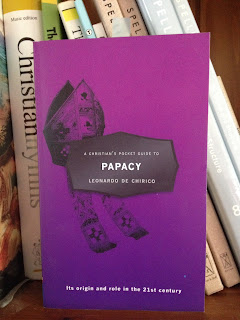A Christian's Pocket Guide to the Papacy
It's origin and role in the 21st century
by Leonardo de ChiricoChristian Focus Publications, Ltd
Scotland 2015
Paperback ISBN 978-1-78191-299-7
I bought this book primarily because I wanted to read something by this author. I was familiar with some of his work from his website vaticanfiles.org and something he had written about the state of evangelical churches in Italy. I'm also interested in the topic, at least inasmuch as how the papacy affects Catholics today in their affiliation with the Roman Catholic church. I'm no expert reviewer, but as I said in my first post this is partly an exercise in getting me to think more about what I've read. So this is a personal unpacking of the book, but I do hope to represent it accurately here.
Pastor de Chirico's book is not long but it is quite dense with facts and ideas. It starts with a discussion of the titles and symbols of the Papacy, and then alternates chapters on the history of it with chapters that look at how Biblical an idea the Papacy is, and how early Protestants and other reformers viewed it. The last two chapters are about the three most recent popes and how the Roman Catholic church deals with conflicting ideas and doctrines, and then a look at the topic of ecumenicism.
I found the chapter on the scriptures the Papacy is supposed to be based on, and then the next-to-last chapter the most helpful. It was good to read an explanation of what the Bible verses actually meant. What was the rock that Jesus talked about when He said He'd build His church on it? What were the keys that He was giving to Peter (I had not known this was a reference to Isaiah 22:22 before)? Was Peter really the Big Man on Campus of the early church?
In chapter 6 it was interesting to read about John Paul II, Benedict XVI, and Francis, but what was really helpful to me in learning more about the Roman Catholic church, and hopefully will be helpful when I have occasion to talk with Roman Catholics about such matters, was to learn about how the church assimilates different ideas into it without letting go of old ideas. Sort of the Borg of religious institutions. This explained a lot to me about why they hold to things that didn't seem to go together in my mind. And why so much syncretism in certain cultures (for example in Mexico) goes so unchallenged.
In the last chapter I was reminded how important it is when talking with people from a different group, to make sure that the terms are the same or that at least you understand what someone else means. Pastor de Chirico explains some terms that are quite different for the Roman Catholics than they would be to a Protestant or evangelical.
Throughout the book there are little symbols beside some notes that are extra to the text. They are "warning" "don't forget" "stop and think" and "point of interest." On the "stop and think" ones I wished I had someone to discuss them with as I was reading them.
As a Reformed Christian it was interesting to read about the Reformer's view of the Papacy, as a Christian it was good to be taken through the scriptures once again with a good explanation of them, and in future I hope some of the things I've learned will be helpful in talking about the Gospel with others.
You can read more about Leonardo de Chirico here:

I've done a small amount of reading on Roman Catholicism in general, but have never read anything about the papacy in particular. This should be interesting; I just put it in my Amazon wish list for payday.
ReplyDeleteI hope you enjoy the book, Tom. Thanks for reading the review today.
DeleteI enjoyed your review and the book sounds very helpful. im off to check out his blog :-)
ReplyDelete